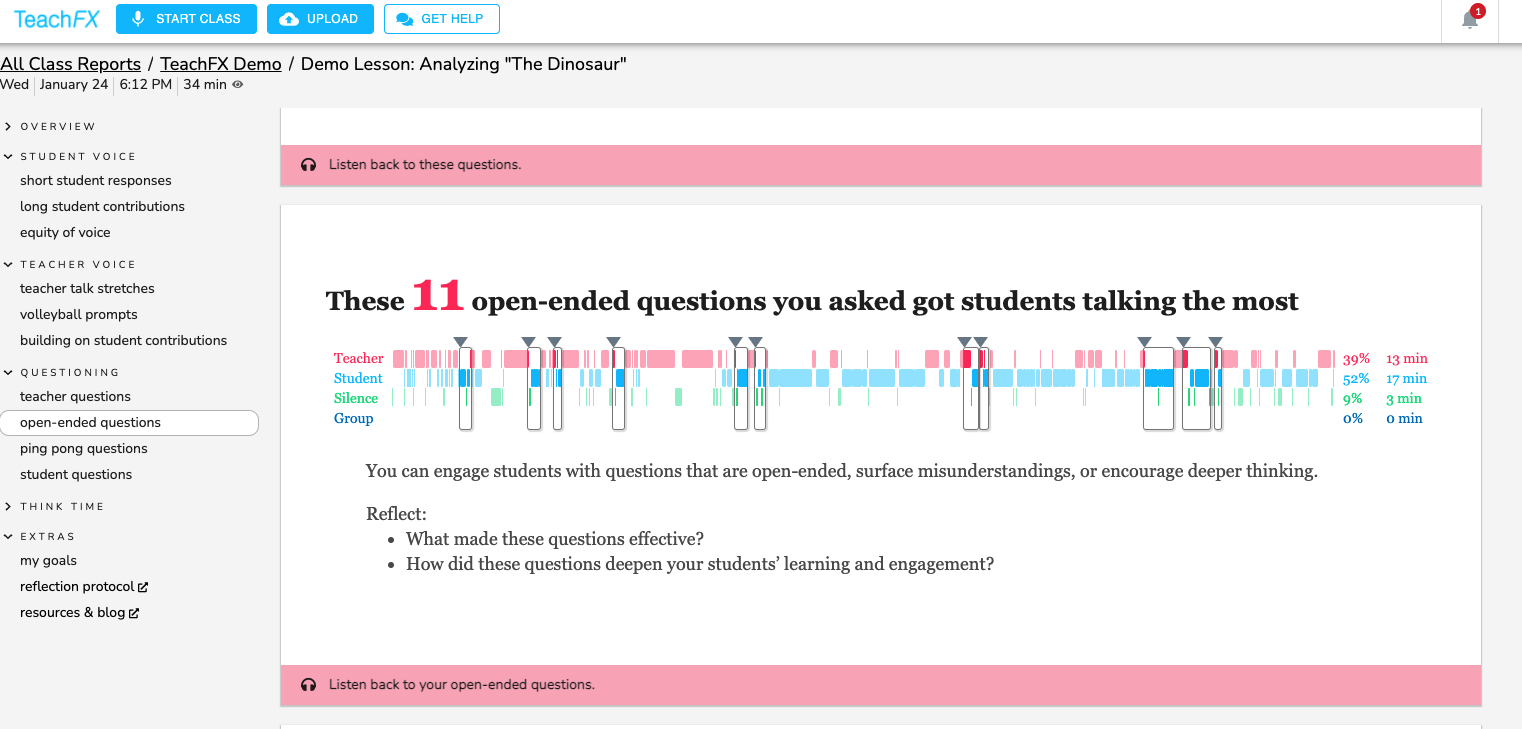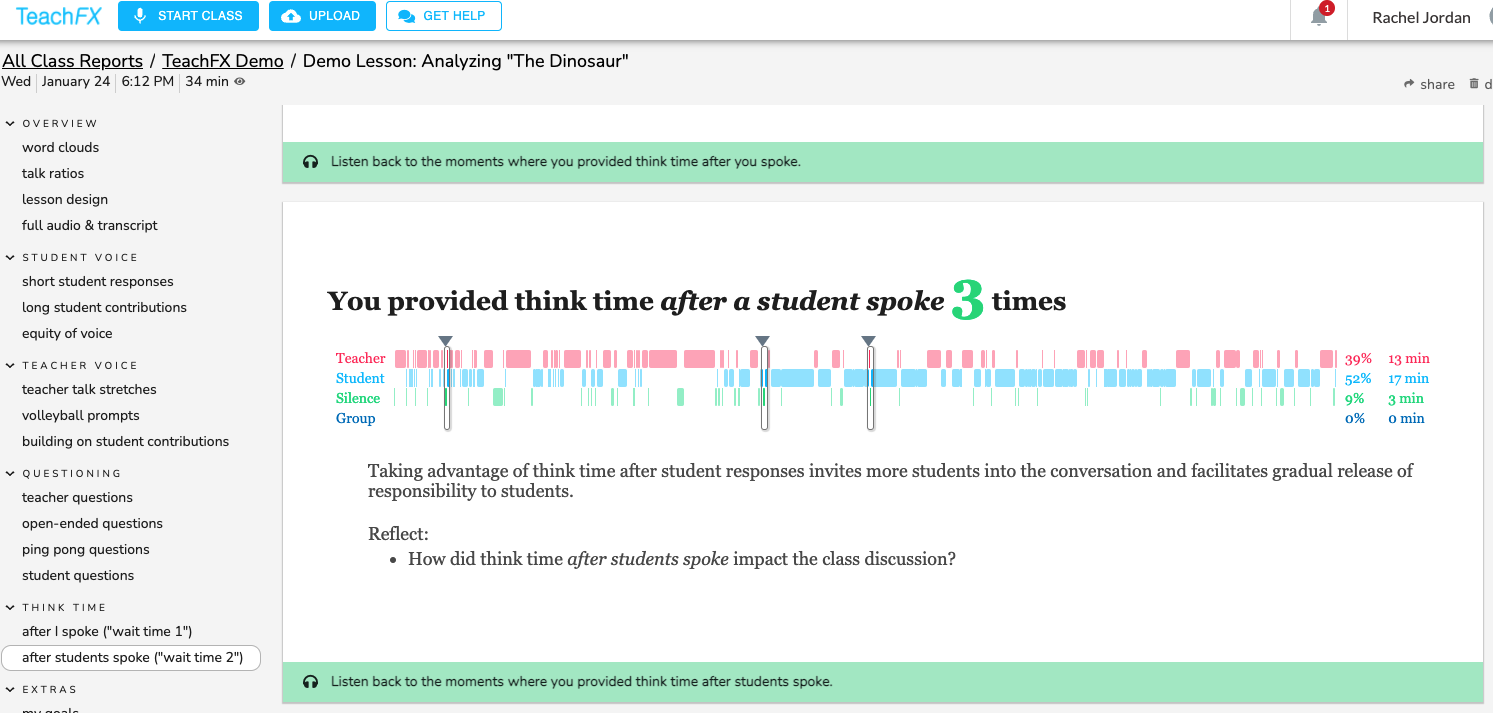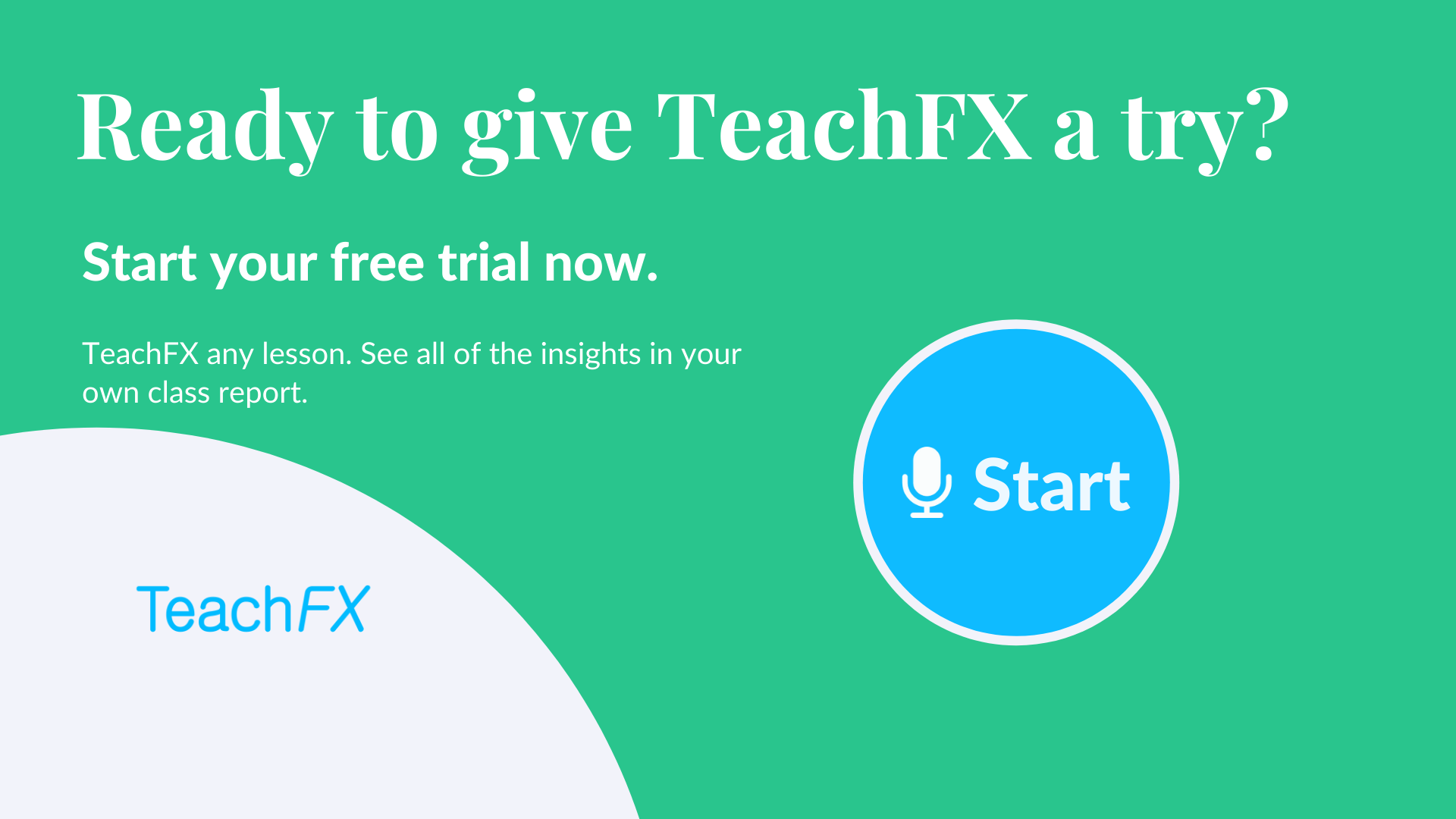New Insights Help Teachers See Classroom Conversation Patterns Even More Clearly
There’s so much happening at once when you’re teaching. It’s nearly impossible to have a complete picture of what really happened during a lesson. Whether you’re teaching or observing. TeachFX is here to change that.
Who's doing the talking? Is it mostly the students or the teacher? Are students interacting with each other? Are they spending time thinking about each other’s contributions? Responding to one another’s questions?
The research is unequivocal – students need to talk to learn. In every classroom, across every subject, meaningful student discourse improves learning. And the best way to weave richer student discourse into your classroom dynamics – or to increase student talk overall – is to know where you’re starting, and how you’re progressing.
And now, the student voice, teacher voice, and questioning insights in your TeachFX class reports help you see visible evidence of the dialogical patterns and instructional practices that support deeper learning in your classroom.
Read on to learn more about how TeachFX helps you see evidence of:
Student voice in your classroom with insight into short student responses and student questions
Teacher voice in your classroom with insight into teacher talk stretches and building on student contributions
Questioning techniques you’re using: teacher questions and open-ended questions
Think time in the form of allowing think time after you speak as well as after your students speak
See Evidence of Student Voice in Your Classroom
Most educators get started with TeachFX because they want to know how much students are actually speaking in the classroom, and what the quality of that student talk is.
Now, in addition to revealing long student contributions (moments when students spoke for 7 seconds or more), TeachFX shares insights about short student responses as well.
(Wondering why these insights measure stretches of student talk that are longer or shorter than 7 seconds? Analyzing thousands of hours of instruction to date, we can see that 7 seconds is approximately the minimum threshold for substantive responses from students. And the more teachers use TeachFX, the more intelligent insights like these will become, for all teachers.)
Short Student Responses
Short student responses can work well to get your class warmed up for deeper conversation.
While longer student responses deepen cognitive engagement as your students develop their thinking aloud and make important connections on their own, the brief and brisk nature of shorter student responses can help to bring your students into the conversation.
And, creating space for short student responses can allow the class to hear ideas from a wide range of your students, and can help bring more introverted students out of their shells.
Want to get deep into the details on how this insight works?
Our short student responses insight finds every stretch of student voice with duration of 1.5 to six seconds long, and that is preceded and followed by teacher voice of at least two seconds.
This insight is specific to statements that students make. Student questions are surfaced in a separate insight.
Our AI is trained to allow for at most three seconds of silence between the teacher and the student, and again between the short student response and the teacher’s voice, to allow for instances of teacher wait time.
Student Questions
Ever wish you could play back all of the questions your students asked today, to figure out how you should adjust your lesson plan for tomorrow?
Or wish you could know how often your students contribute to classroom discussion with statements that are inflected like questions, as if to ask you whether their contribution is “correct”? These moments serve as valuable evidence of the discourse culture in your classroom. And you’ll see them in your student questions insight.
The questions students ask tell us vital information about where they need additional support. They illuminate elements of our classroom culture, such as how comfortable our students feel making mistakes or voicing their confusion.
With the TeachFX student questions insight, you’ll see every moment in the lesson where a student asked a question. (This feature is exclusively available for online classes via the TeachFX-Zoom integration.)
See Teacher Voice at Work in Your Classroom
In addition to revealing insights about student voice in the classroom, TeachFX reveals insights about how your voice impacts and shapes your classroom’s discourse patterns.
The Teacher Voice insights in TeachFX now include new insights: teacher talk stretches and building on student contributions. Here’s how these insights work.
We hope these insights do even more to help teachers and instructional coaches see exactly what’s happening in the classroom, to better understand exactly what instructional practices they want to work on – and to see the results of those practices almost immediately.
Teacher Talk Stretches
This insight isn’t new to TeachFX, but it’s worth noting. Examining the moments when you spoke for the longest stretches of time can help you ensure that your stretches of teacher talk meet your instructional goals.
Sometimes, you need to carry the cognitive load to move the classroom learning forward. And sometimes, these moments present opportunities to pass the ball back to students a bit more. In any case, we surface your longest stretches of teacher voice to facilitate reflection on whether these moments align with your intentions.
Building on Student Contributions
Building on students’ contributions can help students feel valued, connected to their teacher, and essential to the learning happening in the classroom.
When you TeachFX a lesson using the TeachFX-Zoom integration, you’ll see insights into how you engaged in practices of building on student contributions
(This TeachFX insight isn’t new, but the way we surface these moments has greatly improved. And it’s exclusively available for online classes via the TeachFX-Zoom integration.)
Questioning Techniques
Teachers and instructional coaches often find TeachFX when they’re looking for a way to better understand and improve on their use of questioning techniques in the classroom. The new Questioning insights in TeachFX make it easier than ever to see exactly how you’re using these practices, and even to listen back to those key moments in your lesson.
Teacher Questions
In addition to surfacing the questions your students asked during a lesson, TeachFX now shows all of the questions you asked over the course of the lesson, too.
Open-Ended Questions
Open-ended questions help engage students in the conversation, reveal gaps in learning, or encourage deeper thinking. The open-ended questions insight helps you see which questions you asked that got your students talking the most.
This is another insight that’s been updated and improved, making it even better at surfacing the most relevant moments for you and your students.
Think Time
Providing at least three seconds of think time after you speak produces is simple but powerful.
It sends important messages to students, and establishes important cultural norms for your classroom. It has the power to increase student engagement and student talk, and to help facilitate more equitable classrooms by creating space for every student to engage in the classroom discussion and use their voice.
TeachFX helps you see the moments when you made use of think time. And, these insights have just been updated to be more accurate than ever.
Allowing Think Time After I Spoke
See the moments when you allowed for think time after you spoke and before a student spoke, a practice often called wait time one (as coined by education researcher Mary Budd Rowe).
Allowing Think Time After Students Spoke
Taking advantage of think time after student responses invites more students into the conversation and facilitates gradual release of responsibility to students.
With this insight, you’ll see the moments when you allowed for think time after a student spoke that led to more student voice, called wait time two (also a term coined by Mary Budd Rowe).
Our goal is to make it as easy as possible for you to gain clarity about what’s going on in your classroom. I’d love to hear how these updates help you do just that, and how you’re using them to deepen student learning in your classroom.
How can we partner with you and your teachers? Contact us to start the conversation.









